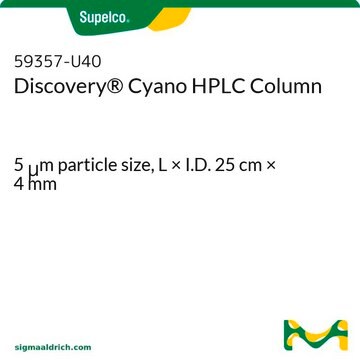59586-U
Discovery® Cyano (5 µm) HPLC Columns
L × I.D. 2 cm × 4 mm Supelguard Guard Cartridge, pkg of 2 ea, Guard Cartridge holder required for use
About This Item
Recommended Products
Product Name
Discovery® Cyano Supelguard Cartridge, 5 μm particle size, L × I.D. 2 cm × 4 mm
material
stainless steel column
Agency
suitable for USP L10
description
Supelguard Cartridge
product line
Discovery®
feature
endcapped
packaging
pkg of 2 ea
technique(s)
HPLC: suitable
L × I.D.
2 cm × 4 mm
surface area
200 m2/g
matrix
fully porous particle
matrix active group
cyano phase
particle size
5 μm
pore size
180 Å
operating pH
2-8
application(s)
food and beverages
separation technique
hydrophilic interaction (HILIC)
normal phase
reversed phase
Looking for similar products? Visit Product Comparison Guide
Related Categories
Choose from one of the most recent versions:
Certificates of Analysis (COA)
It looks like we've run into a problem, but you can still download Certificates of Analysis from our Documents section.
If you need assistance, please contact Customer Support.
Already Own This Product?
Find documentation for the products that you have recently purchased in the Document Library.
Our team of scientists has experience in all areas of research including Life Science, Material Science, Chemical Synthesis, Chromatography, Analytical and many others.
Contact Technical Service






